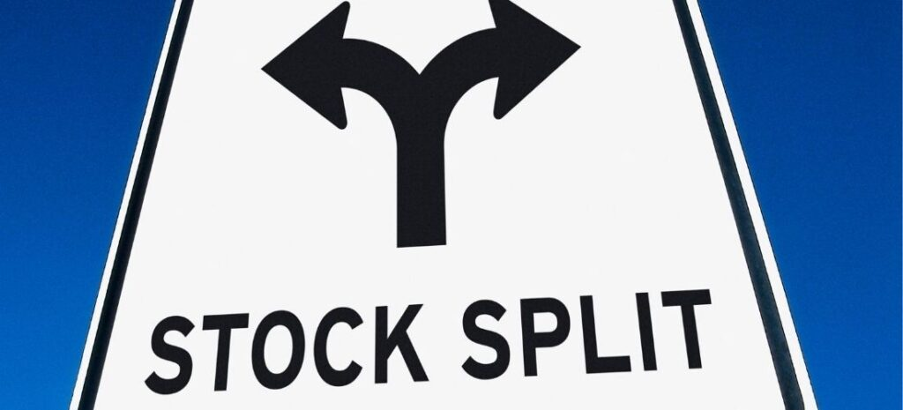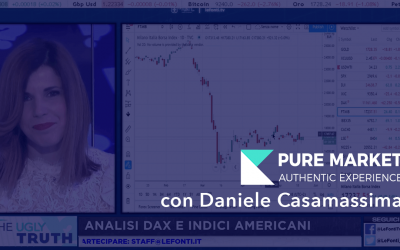What is a stock split?
In simple terms, a stock split is a when a company divides it’s existing shares of its stock into multiple new shares to boost the stock’s liquidity. Although the number of shares outstanding increases by a specific multiple, the total dollar value of the shares remains the same compared to pre-split amounts, because the split does not add any real value.
The most common split ratios are 2-for-1 or 3-for-1 which means that the stockholder will have two or three shares after the split takes place, respectively, for every share held prior to the split.
For example, if the company whose shares you hold decides of a 3 for 1 stock split, as a shareholder you will get 3 shares for every 1 share held. So, if the company had 10,000 outstanding shares before the share split, now the number of outstanding shares will be 30,000.
A stock split is a corporate action in which a company divides its existing shares into multiple shares. Basically, companies choose to split their shares so they can lower the trading price of their stock to a range deemed comfortable by most investors and increase the liquidity of the shares.
Most investors are more comfortable purchasing, say, 100 shares of $10 stock as opposed to 10 shares of $100 stock. Thus, when a company’s share price has risen substantially, many public firms will end up declaring a stock split at some point to reduce the price to a more popular trading price. Although the number of shares outstanding increases during a stock split, the total dollar value of the shares remains the same compared to pre-split amounts, because the split does not add any real value.

Reasons for a stock split
1. Increase liquidity
This is one of the primary reasons for share split. Often, the share price of a company may be too high for investors to buy and any further rise in prices can discourage them from participating. By reducing value of a stock through split, the shares are made accessible to all.
2. Increase stockholder base
With stock split, the number of outstanding shares of a company increases and it gives opportunity to more investors to purchase shares. This helps increase the stockholder base for a company.
3. Perception of future growth
Companies going for stock splits are perceived to be growing entities. It is a general perception among investors that if a company goes for stock split it has plans for growth, and this belief creates a positive image of the company in the market.
Reverse stock splits
A reverse stock split is when a company decreases the number of shares outstanding in the market by canceling the current shares and issuing fewer new shares based on a predetermined ratio. For example, in a 2:1 reverse stock split, a company would take every two shares and replace them with one share. A reverse stock split results in an increase in the price per share.
A stock split, on the other hand, is when a company increases the number of shares outstanding by splitting them into multiple shares. So, in a 2:1 stock split, each share of stock would be split into two shares, with the result being a decrease in the price per share.
Stock splits are most commonly associated with positive news, as they typically happen when a stock has performed quite well, and they generally result in an increased number of shares owned by each investor. But those splits, officially called forward stock splits, are only one variety. It’s also possible for a company to complete a reverse stock split, which works in the exact opposite way. Unlike forward splits, reverse stock splits leave shareholders with fewer shares, and they often result from situations in which a stock has lost a substantial amount of its value.
Calculating the effects of a reverse stock split is easy. Simply divide the number of shares you own by the split ratio and multiply the pre-split share price by the same amount. For instance, say a stock trades at $1 per share and the company does a 1-for-10 reverse split. If you own 1,000 shares — worth $1,000 at current prices — you’ll get one new share for every 10 old shares you own, or 100 new shares. Immediately following the reverse split, the stock price will rise tenfold to $10 per share. That will leave your smaller position still worth the same amount, as 100 shares multiplied by $10 per share equals $1,000. To be perfectly clear, a reverse stock split doesn’t change the overall value of your investment — at least not all by itself.
Why do a companies do reverse stock splits?
A company does a reverse split to get its share price up. The most common reason for doing so is to meet a requirement from a stock exchange to avoid having its shares delisted. For example, the New York Stock Exchange has rules that allow it to delist a stock that trades below $1 per share for an extended period. Plus, many institutional investors are not permitted to invest in stocks with share prices below a certain minimum.
1. To prevent its stock from being delisted by boosting its share price.
Being listed on a major exchange is considered an advantage for a company in terms of attracting equity investors. If a stock price falls below $1, the stock is at risk of being delisted from stock exchanges that have minimum share price rules. Reverse stock splits boost the share price enough to avoid delisting.
2. To boost the company’s public image.
Typically, stock with a share price in the single digits is seen as risky. As its price approaches $1, a stock may be viewed as a penny stock by investors. There is often a negative stigma attached to penny stocks traded only over-the-counter and a company may try to avoid this label and protect its brand by engaging in a reverse split.
3. To get more attention from analysts.
A company may also wish to increase its share price to attract more attention from analysts and influential investors. Higher-priced stocks tend to attract more attention from market analysts, and this is viewed as good marketing.
4. To avoid delisting from options exchanges.
Typically, a company’s share price must be greater than $5 for options to be traded on the stock. If a company’s stock price falls too low for options to be traded on it, the shares might lose interest from hedge funds and wealthy institutional investors who invest billions of dollars in the market and hedge their positions via options. If portfolio managers can’t hedge their long positions, due to delisting from an options exchange, they may sell the stock.
Pure Market TRADING, ALLA RICERCA DEL SALTO DI QUALITÀ GLI STEP FONDAMENTALI con Daniele Casamassima
MT4 is a standalone trading platform designed to help you automate your trading. While it is commonly associated with forex trading it can be used to trade other markets as well.
Pure Market Anlisi dax e indici americani con Daniele Casamassima e Cristoforo Giordano
MT4 is a standalone trading platform designed to help you automate your trading. While it is commonly associated with forex trading it can be used to trade other markets as well.
MetaTrader
MetaTrader – Download la Piattaforma Trading MetaTrader – MetaTrader 4 è la migliore piattaforma di trading online per i trader Forex.





